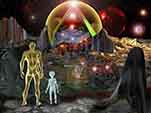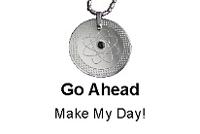Jon Rappoport
September 18, 2023
I’m 85, so when I started watching television, it was small and it was black and white.
There were maybe five channels.
I watched a lot of baseball—the Yankees and Dodgers—and B Westerns, movies with speeded up horse chases and guns going off and guys falling off the horses.
The baseball was elegant. In black and white, there was a certain distance from the action. It was real, but you weren’t clobbered on the head with blue and red and yellow and green. It was as if you were watching a black and white film that was Live, in the moment. The plot wasn’t decided. It was unfolding. A minor miracle.
Howdy Doody was the big show for kids. And there was a studio audience of kids. But I wasn’t impressed. The presence of kids on the screen wasn’t a pull for me. I wasn’t automatically happy to see kids my own age on television. (Much later, I was mystified when I realized lots of kids were delighted to see “themselves” on sit-coms about families. Something had changed without me knowing it. A new generation of kids suddenly wanted a mirror. What was that all about? I wanted to grow up. All the kids I knew wanted to. But these new kids wanted to look at their own reflections. And of course, those reflections were distorted and reduced. It was as if the new kids needed training in how to behave. They were blank slates. How did that happen? Kids actually wanted to see “themselves” dance on dance shows. Brain damage? New chemicals in breakfast cereals? Explosive use of pesticides after WW2? And leaking in, this mystery of the blank slate was accompanied by Buying Shit. The new kiddies were all of sudden consumers. They were Making Choices. In the Marketplace. This product or that product. Crazy. Absolutely nuts. As I began to exit from watching television, the family sit-coms were coming on with a roar. When I tried to watch them, I didn’t laugh. Nothing was funny. The kids on the screen were dumb. They were reacting to little stupid situations I’d never encountered in real life, so why bother? The kids on the screen—as I realized later—were also starting to form into little GROUPS. Cliques. This was entirely new to me. Little suburban bunches. The magnets that were making this happen? Unknown. The whole process was useless as far as I was concerned.)
Maybe when I was 30, looking back on television, I saw that MARKETING PROS had been at work all along. Idiots with college degrees who were plotting the capture of demographics. These pros were front men for companies selling ever-expanding lines of crap. The pros were influencing the TV shows that were birthed for the public. Lowest common denominators were MAJOR considerations. What do the largest number of people want to watch? What will they like? What will they put up with? Eyeballs equal advertisers equal sales of products. The pros were guessing about the denominators. In the process, they were painting pictures of an American landscape. Leave It to Beaver was a piece of the landscape. Shit for brains. But with all the blank slate kids out there, looking for clues about what Reality was, it worked.
See, the blank slate was the thing. It was a fact or it had been caressed into being a fact by television.
If you—a professional only concerned with selling to blank slates—were working in television, you were working in diamond mines of consumerism.
Consumerism was the philosophy of On the Tit nursed by the pros. What you had to grasp was: there were no ideas in or behind Consumerism. THAT’S WHAT MADE IT WHAT IT WAS. As a marketing pro, you had to throw away the best part of your education. You had to see the new handwriting on the wall. Sell. To buyers. Period.
That basic transaction was the All. The rest had to be cut away and discarded.
And wasn’t politics the same? What should the mayor and the senator and the president say, in order to stay in office? The marketing pros took over that scene like the body snatchers.
The pros made pragmatic sense. They sliced away principle and policy as mere adjuncts.
“Sir, think of your life as happening on television. That’s the clue you have to adjust yourself to. What would you say on television and how would you say it, in order to sell yourself to the constituency?”
Lies and truth are ancient awkward categories.
They don’t work.
Marketing is the study of how to make people believe. It has always been with us, but it became the new philosophy for all the smart people.
“I have a PhD from Harvard in Political Science, and now I focus on marketing Chinese bubble machines to kids. It’s challenging work.”
The President will ask this man to come on board as a consultant to his Council of Economic Advisors.
Way back in time, television spawned this.
When men said, “We can put anything on this blank screen for blank slates.”
(Now, it’s: “Hey, Shika, you’ve got a great body and you’re a gardener. If you start making videos of yourself, naked, growing vegetables in your back yard, you know, like instruction, you can make a whole lot of cash posting the videos.”)
So where DID those first blank slate kids I came across come from?
Some wrinkles in reincarnation may have played a role. I’ll put that aside for now. The parents had to be involved. In the 1950s, they were starting to back away from actually raising their children. They were also standing in awe of the burgeoning consumerist economy. They were in a state of shock. So they let things slide. If the kids wanted to buy more than kids ever bought, well, okay. Why not? Give the kids more clothes, more toys, buy them a car when they turned 16.
Parents back away, consumerism moves in.
If you don’t actively raise a kid, if you leave him largely alone, there’s a chance he’ll go blank. He’ll look at the world as a mystery. He’ll wait for instructions. If they come from television, so be it. They have to come from somewhere.
Family sit-coms, commercials, authoritative men delivering the news, a whole country was taking shape, on the screen, in the 1950s. The blank slates were sucking it in.
Plus—talking about the new rising post-WW2 middle class—the parents were giving in, buying more stuff, because it was there and they had more money than anyone in their family ever had. The kids watched the parents buying jewelry and clothes and cosmetics and cars and lawnmowers and freezers and frozen food and garden plants and doofus artwork and false teeth and fountain pens and gas logs and roll-on lawns and tools for a garage workshop and furniture and TV sets and toasters and motorcycles and hair dryers and a few antiques and gold chains and coffeemakers and rugs and bric-a-brac for the mantle and picture frames and over the counter drugs…and then there were the DOCTORS. Appointments were made, physical check-ups were run, and, of course, any one of 50 symptoms in the kids required an immediate visit to the doc, and medicines were prescribed.
ALL of this caught on, as the kids watched their parents buy, buy, and buy. “Looks good, can I try it, too?”
ALL of this was bolstered and initiated by ads and more ads on television.
Television, in fact, became a PRIMARY marker of what was credible.
It’s real BECAUSE it’s on television.
(Now, he’s real because he has a YouTube channel.)
When I came back to television, in the mid-1970s, after an absence of 15 years or so, the shows all looked GROTESQUE. The levels of pretension and out-front fakery were stunning. The people, the stars, the conversations, the plot lines, the expressions on the faces…awesomely repellent to behold.
CONTINUE READING: https://jonrappoport.substack.com/p/television-the-light-of-life






































